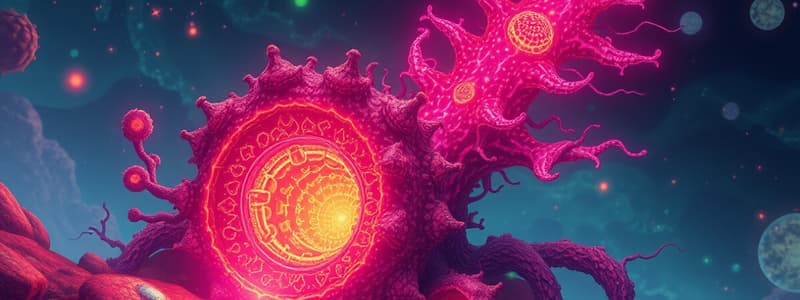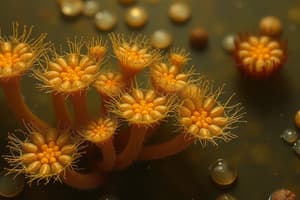Podcast
Questions and Answers
Which of the following characteristics is NOT commonly associated with organisms in Kingdom Monera?
Which of the following characteristics is NOT commonly associated with organisms in Kingdom Monera?
- Ability to reproduce asexually
- Single-celled organisms
- Presence of membrane-bound organelles (correct)
- Prokaryotic cell structure
What cellular structure do all Monera organisms lack?
What cellular structure do all Monera organisms lack?
- Nucleus (correct)
- Plasma membrane
- Ribosomes
- Mitochondria
Which of the following groups are included in Kingdom Monera?
Which of the following groups are included in Kingdom Monera?
- Fungi and Protozoa
- Algae and Plants
- Animalia and Viruses
- Bacteria and Archaea (correct)
How do most Monera organisms obtain nutrition?
How do most Monera organisms obtain nutrition?
What is the primary method of reproduction in Monera?
What is the primary method of reproduction in Monera?
Flashcards
Monera Characteristics
Monera Characteristics
Monera organisms lack membrane-bound organelles like mitochondria and endoplasmic reticulum.
Absence of Nucleus
Absence of Nucleus
Monera organisms lack a nucleus, their genetic material is not enclosed within a membrane.
Monera Groups
Monera Groups
Kingdom Monera includes Bacteria and Archaea, which are prokaryotic microorganisms.
Monera Nutrition
Monera Nutrition
Signup and view all the flashcards
Binary Fission
Binary Fission
Signup and view all the flashcards
Study Notes
Characteristics of Kingdom Monera
- Organisms in Kingdom Monera are typically unicellular and prokaryotic.
- They lack membrane-bound organelles, which distinguishes them from eukaryotic organisms.
- Commonly found characteristics do not include complex cellular structures like a nucleus or mitochondria.
Cellular Structure in Monera
- All Monera organisms lack a true nucleus (nuclear envelope), containing their genetic material in a nucleoid region instead.
Groups Included in Kingdom Monera
- Kingdom Monera includes two main groups: Bacteria and Archaea.
- Bacteria are further classified into various groups, such as cocci, bacilli, and spirilla based on shape.
Nutrition in Monera
- Most Monera organisms obtain nutrition through various modes, including photosynthesis, chemosynthesis, and heterotrophy.
- Some bacteria are autotrophic, generating energy through chemical means or light.
Reproduction in Monera
- The primary method of reproduction in Monera is asexual, predominantly binary fission.
- This process involves the division of a single organism into two identical daughter cells, allowing rapid population growth.
Studying That Suits You
Use AI to generate personalized quizzes and flashcards to suit your learning preferences.




